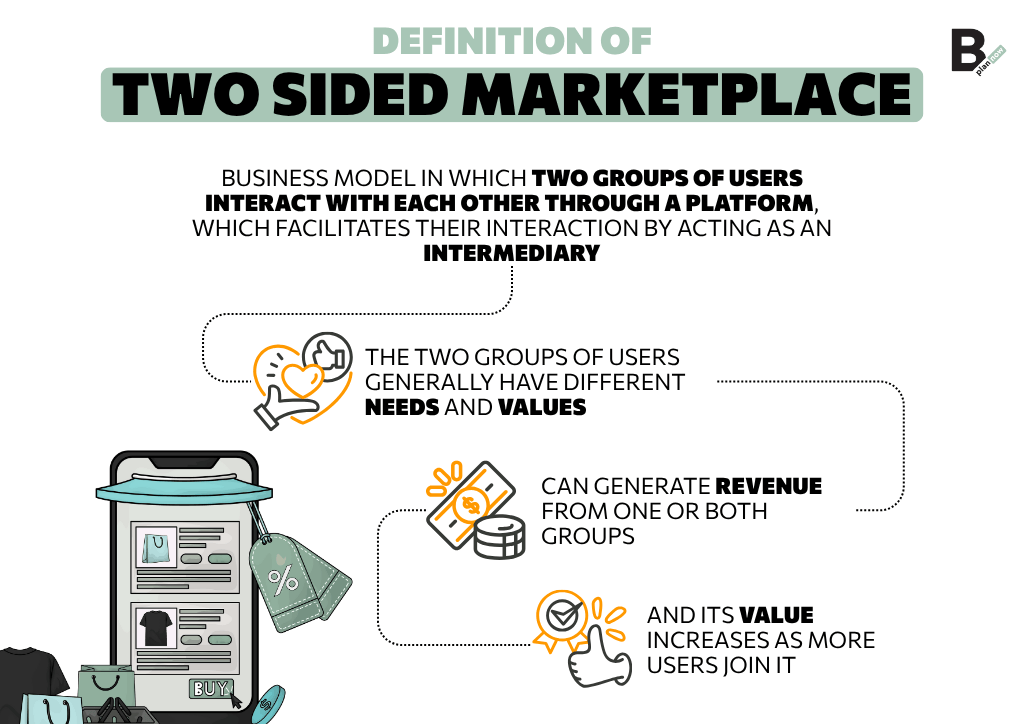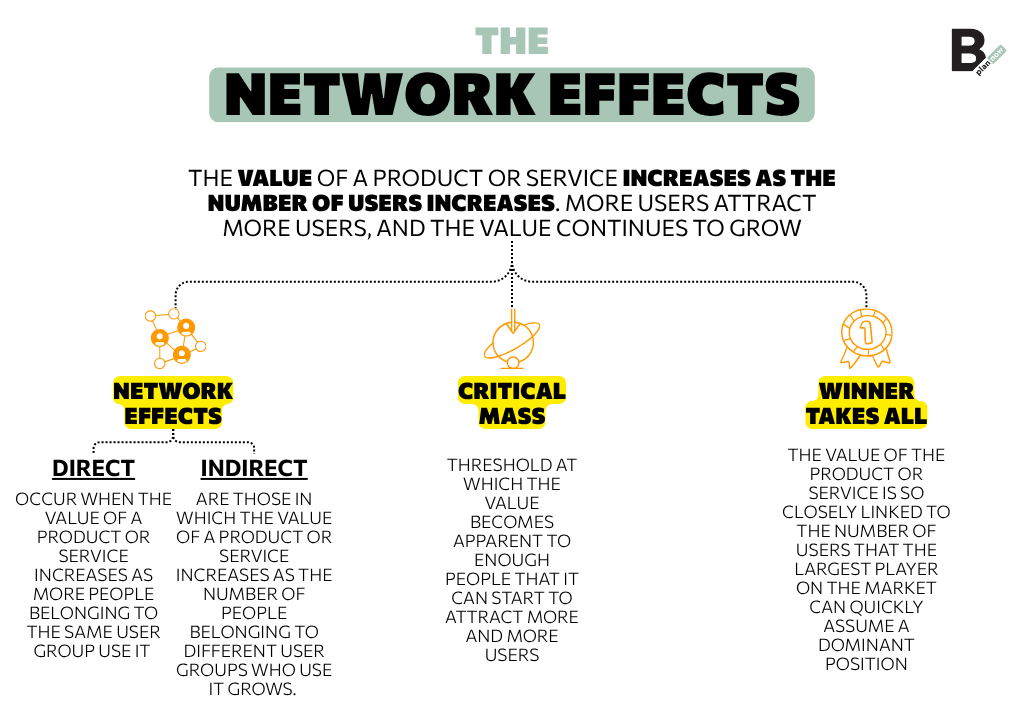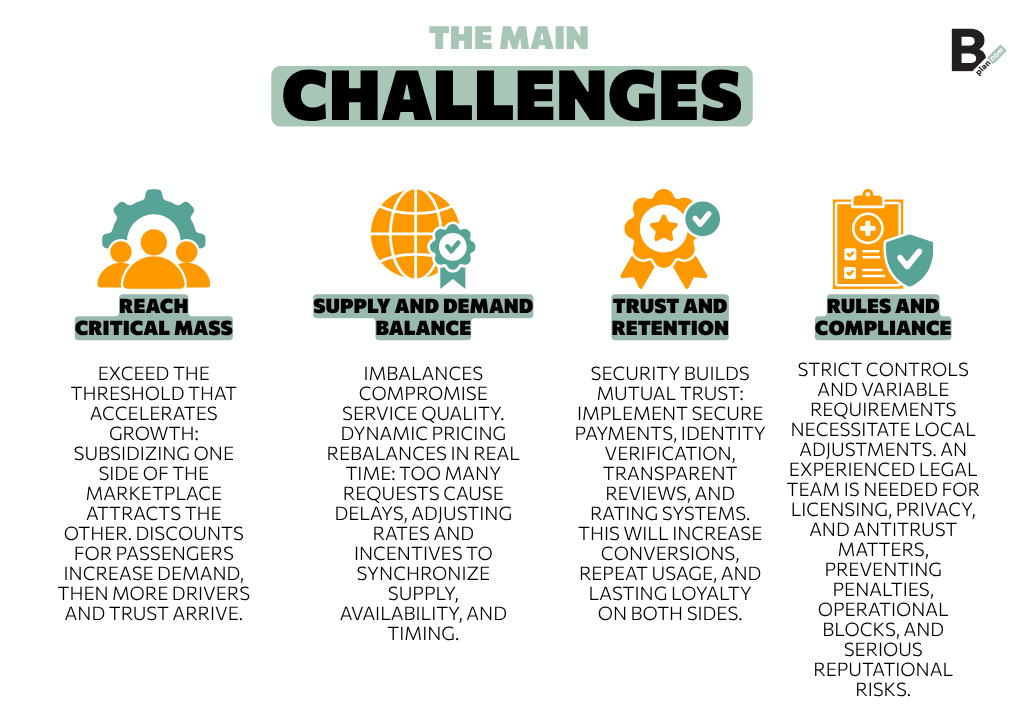Two-Sided Marketplaces are a winning model for digital platforms. To be able to understand why, you must first know precisely what they are and how they work. In this guide we will delve into every aspect of two-sided marketplaces.
What is a Two-Sided Marketplace and how it works
To fully understand what a Two-Sided Marketplace is, it is important to start with the definition and know what distinguishes two-sided marketplaces from traditional marketplaces.
Definition and difference from traditional marketplaces

A Two-Sided Marketplace is a business model in which two groups of users interact with each other through a platform, which facilitates their interaction by acting as an intermediary.
Compared to traditional marketplaces, in this case the two user groups generally have different needs and values. A Two-Sided Marketplace, moreover, can generate revenue from only one of the groups or both, and its value increases as more users join it, whereas a traditional marketplace generally meets the needs of a single group, focusing on connecting buyers and sellers and creating value through transaction volumes.
Operational complexity is another important difference: two-sided marketplaces involve more nuanced operational strategies. Revenue models are also more varied because they depend on which user group is able to bear the greatest costs and where the value is highest.
Examples of successful two-sided marketplaces.
There are many examples of successful two-sided marketplaces. Prominent in the long list are the names of large companies such as AirBnB and Uber: the former connects travelers and homeowners, while the latter acts as a conduit between drivers and passengers.
Another “excellent” example of Two-Sided Marketplace is Upwork: within this platform freelancers and businesses that need help to complete specific projects have a way to meet.
The heart of the model: network effects
The heart of the bilateral marketplace model is the so-called network effects. These effects refer to the fact that the value of a product or service increases as the number of users who use it increases. More users attract more users and the value thus continues to grow.
For those who decide to adopt a two-sided marketplace, it is critical to understand how network effects work because within these platforms the value of the product or service is tied to the interaction between two distinct user groups. Below are some useful pointers.

Direct and indirect network effects
You should know, first of all, that network effects can be direct or indirect.
The former occur when the value of a product or service increases as more people in the same user group use it (social platforms, such as Facebook, are an example).
Indirect network effects, on the other hand, are those in which the value of a product/service increases as more people from different user groups use it (a console for video games such as PlayStation, for example, becomes more attractive to developers if the numbers of players increase).
The concept of critical mass
For network effects to occur, it is essential that the product or service reaches what is known as a critical mass of users, that is, that threshold by which the value becomes apparent to enough people that it can begin to attract more and more users.
The “winner takes all” dynamic in digital markets.
The third factor to consider is the “winner takes all” dynamic that governs digital markets with strong network effects: the value of the product or service is so tied to the number of users that the largest player in the market can quickly assume a dominant position.
The strategic role of the platform owner
The owner of a bilateral marketplace plays a strategic role because it is up to him to create a balanced platform for both groups involved. And more.
Creating value for both sides of the marketplace.
The owner of a Two-Sided Marketplace must necessarily ensure that value is created for both sides of the marketplace, so as to continue to engage them, keep them active, and avoid imbalances that can result in a negative network effect.
Ensure a smooth and safe user experience.
Another “duty” for a bilateral platform owner is to ensure that the user experience is smooth for both buyers and sellers. Not only that, it must also be secure for all parties involved, with scam-proof transactions, easy access to payments, and a transparent dispute resolution process.
Continuous monitoring of the supply and demand balance.
Those who own a Two-Sided marketplace must also monitor the ecosystem so that they can ensure that it remains balanced. Monitoring the ecosystem means analyzing how user engagement, prices, and the number of users change (if at all).
The main challenges to be faced
To achieve success with a Two-Sided Marketplace, a number of challenges must be faced and overcome. You are about to learn about the most relevant ones.

Achieving and maintaining critical mass
We have already introduced in the previous lines the concept of critical mass, that is, that limit in the number of users beyond which it is possible to succeed in attracting more and more.
It is not always easy to reach it. One ploy to succeed in this can be to subsidize one side of the market so as to then attract the other side as well (e.g., discounted rides for passengers can attract more passengers and subsequently more drivers as well).
Balancing supply and demand without creating imbalances
Balancing supply and demand without creating an imbalance on either side is another difficult task facing those who manage a two-sided marketplace.
Having too much demand (or too much supply) has repercussions on service quality: for example (to stay with the case cited above) too many passengers compared to car drivers can result in long waits. One possible solution is to leverage dynamic pricing to balance supply and demand in real time.
Winning and retaining users from both sides
The security issue, as highlighted earlier, is crucial in two-sided marketplaces because each user group must be able to trust the platform, especially when it comes to completing the transaction.
This is why you should adopt secure payment systems, proper verification procedures, and transparent user evaluation tools. Only in this way can you win and retain users, on both sides.
Regulation and compliance: a crucial issue
Over the past few years regulators and antitrust authorities have placed two-sided marketplaces under close scrutiny, so they must necessarily meet certain requirements, but these vary locally.
Relying on an experienced legal team has therefore become a necessity if one wants to adapt the business model to different markets while complying with all regulations.
Monetization and pricing strategies in two-sided marketplaces
In two-sided marketplaces, monetization and pricing strategies must necessarily take into account the needs of all stakeholders. This, of course, complicates plans somewhat because it becomes critical for the platform to identify a strategy that does not upset either of the two user groups, risking alienating them. Fortunately, there are several options available.
Commissions, subscriptions, freemiums and cross-subsidies.
In two-sided marketplaces, commissions typically relate either to transactions or to access to the platform.
Marketplaces of this type also often use subscriptions, including freemium versions. The latter freemium business model is a useful strategy because it allows them to attract a broader base of users, securing revenue from those who are willing to pay for a more comprehensive service. Freemium pricing, in fact, involves a basic version being offered for free and additional features being paid for.
Cross-subsidies play a crucial role in Two-Sided Marketplaces: they involve one group of users paying more than they have to for the product or service so that the increased revenue is used to subsidize the costs of the other group of users. They are important because, ultimately, they ensure benefits to both user groups and encourage their participation.
Dynamic pricing to adapt to demand
Dynamic prices, as highlighted a few lines above, are crucial because they help to strike the right balance between supply and demand and adjust in real time to new market conditions, without creating imbalances between the two user groups.
Optimizing the revenue model according to the type of users
In order to identify the right strategy, it is necessary to optimize the revenue model according to the type of platform users. To this end, it is useful to analyze and segment customers, creating distinct groups based on certain characteristics deemed relevant, such as behavior, needs, and expected value.
Technologies and innovations to scale a platform
As bilateral markets are growing exponentially, it is inevitable that they must contend with the latest technological advancement, which provides and will continue to provide valuable assists to scale such a platform.
Artificial intelligence and personalization
Personalization is a concept that will become increasingly central to Two-Sided Marketplaces because it is what enables them to offer more value to customers and better retain them. Artificial intelligence is a valuable ally for platforms that, by leveraging increasingly sophisticated algorithms, can offer services that are increasingly tailored to users’ specific needs.
Blockchain and transaction security
Blockchain technology is an innovation that can be instrumental for bilateral markets, since it ensures a transparent and absolutely secure way to complete transactions. Not only that, it can also reduce costs.
UX and infrastructure: critical elements for growth
Technological advances in User Experience are equally critical to the growth of Two-Sided Marketplaces, since the platform (and its infrastructure) is precisely what facilitates the meeting of two sets of users. You have to keep in mind that within marketplaces of this type, User Experience is not just about the individual user; it also determines how the user experience of one group of users affects the other group.
What makes a two-sided marketplace successful?
We are nearing the end of this guide but there is still one question that is probably buzzing in your head and that is: but what really makes a two-sided marketplace successful? There are several aspects to consider.
Focus on niches and quality of interactions
Finding the most profitable market niches is a great place to start if you want to make your two-sided marketplace truly successful.
The quality of interactions, which must be smooth and of value to both user groups, is also critical to the success of a two-sided marketplace. This quality is reflected, for example, in the ease with which users can find what they are looking for within the platform and, more generally, in the platform’s ability to meet all their needs.
Differentiating from competitors with real value
In addition to focusing on niche markets, a Two-Sided Marketplace can differentiate itself from its competitors by developing unique features for its users or again by focusing heavily on the user experience. Whatever the strategy, being able to provide real, tangible value to users is key.
The importance of community and trust
Another aspect to consider in order to bring a two-sided marketplace to success is the importance of community and the trust that users reserve for the platform. We have discussed this on several occasions, but to add to our puzzle it may be helpful to quote the words of James Currier:
“Two-sided marketplaces are exercises in trust: if one side doesn’t trust, the other side doesn’t show up.“
Why startups look to the two-sided model
We can only conclude this guide dedicated to Two-Sided Marketplaces with a special focus devoted to startups.
Companies looking for rapid expansion are attracted to this particular model because it allows for very fast growth, since the value is directly proportional to the number of users.
Not only that, two-sided marketplaces foster (indeed, create) interaction between groups of users who were previously out of touch with each other, thus enabling startups to access new markets.
Two-Sided Marketplaces, finally, contemplate different ways to monetize thus ensuring a wide range of possibilities to generate revenue.
Do you want to read all the articles related to the stage your startup is in?


